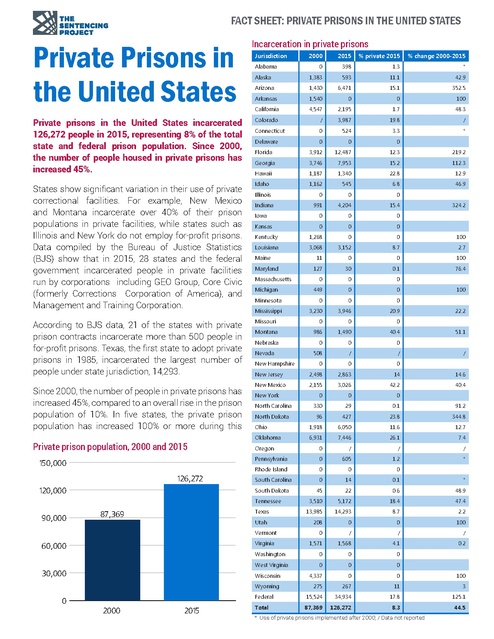The Sentencing Project - Fact Sheet Private Prisons in the United States, 2017
Download original document:

Document text

Document text
This text is machine-read, and may contain errors. Check the original document to verify accuracy.
FACT SHEET: PRIVATE PRISONS IN THE UNITED STATES Private Prisons in the United States Private prisons in the United States incarcerated 126,272 people in 2015, representing 8% of the total state and federal prison population. Since 2000, the number of people housed in private prisons has increased 45%. States show significant variation in their use of private correctional facilities. For example, New Mexico and Montana incarcerate over 40% of their prison populations in private facilities, while states such as Illinois and New York do not employ for-profit prisons. Data compiled by the Bureau of Justice Statistics (BJS) show that in 2015, 28 states and the federal government incarcerated people in private facilities run by corporations including GEO Group, Core Civic (formerly Corrections Corporation of America), and Management and Training Corporation. According to BJS data, 21 of the states with private prison contracts incarcerate more than 500 people in for-profit prisons. Texas, the first state to adopt private prisons in 1985, incarcerated the largest number of people under state jurisdiction, 14,293. Since 2000, the number of people in private prisons has increased 45%, compared to an overall rise in the prison population of 10%. In five states, the private prison population has increased 100% or more during this Private prison population, 2000 and 2015 150,000 126,272 120,000 Incarceration in private prisons Jurisdiction 2000 2015 % private 2015 0 398 1.3 * Alaska 1,383 593 11.1 -42.9 Arizona 1,430 6,471 15.1 352.5 Arkansas 1,540 0 0 -100 California 4,547 2,195 1.7 -48.3 Colorado / 3,987 19.8 / Connecticut 0 524 3.3 * Delaware 0 0 0 Florida 3,912 12,487 12.3 219.2 Georgia 3,746 7,953 15.2 112.3 Hawaii 1,187 1,340 22.8 12.9 Idaho 1,162 545 6.8 -46.9 Illinois 0 0 0 Alabama Indiana 991 4,204 15.4 Iowa 0 0 0 Kansas 0 0 0 1,268 0 0 Louisiana 3,068 3,152 8.7 2.7 11 0 0 -100 127 30 0.1 -76.4 Maine Maryland Massachusetts 0 0 0 449 0 0 Minnesota 0 0 0 Mississippi 3,230 3,946 20.9 Michigan Missouri 0 0 0 Montana 986 1,490 40.4 Nebraska 0 0 0 Nevada 2000 2015 51.1 / / 0 New Jersey 2,498 2,863 14 14.6 New Mexico 2,155 3,026 42.2 40.4 New York / 0 0 0 North Carolina 330 29 0.1 -91.2 North Dakota 96 427 23.8 344.8 Ohio 1,918 6,050 11.6 12.7 Oklahoma 7.4 6,931 7,446 26.1 Oregon 0 / / / Pennsylvania 0 605 1.2 * Rhode Island 0 0 0 South Carolina 0 14 0.1 * South Dakota 45 22 0.6 -48.9 3,510 5,172 18.4 47.4 13,985 14,293 8.7 2.2 208 0 0 -100 0 / / / 1,571 1,568 4.1 -0.2 Washington 0 0 0 West Virginia 0 0 0 Virginia 0 22.2 0 Vermont 30,000 -100 0 Utah 60,000 -100 508 New Hampshire Texas 87,369 324.2 Kentucky Tennessee 90,000 % change 2000-2015 Wisconsin 4,337 0 0 Wyoming 275 267 11 -3 Federal 15,524 34,934 17.8 125.1 Total 87,369 126,272 8.3 44.5 * Use of private prisons implemented after 2000; / Data not reported -100 FACT SHEET: PRIVATE PRISONS IN THE UNITED STATES Proportion of incarcerated population in private prisons, 2015 No private prisons 0.1 - 10% 10 - 20% 20 - 30% >30% * Data not reported for Nevada, Oregon and Vermont period. The federal prison system experienced a 125% increase in use of private prisons since 2000 reaching 34,934 people in private facilities in 2015. Despite the significant growth in private prisons since 2000, the number of people housed in these facilities has declined 8% since reaching a national peak population of 137,220 in 2012. Since 2000 six states — Arkansas, Kentucky, Maine, Michigan, Utah and Wisconsin — have eliminated their use of private prisons due to concerns about safety and cost-cutting. An additional six states saw reductions of 40% or more in the use of private prisons during this period. At the federal level, a 2016 Obama Administration policy shift to reduce reliance and ultimately phase out private prison contracts was reversed by Attorney General Jeff Sessions in February 2017. The reversal took place despite significant declines in the federal prison population and a scathing report by the Justice Department’s Office of the Inspector General that found federally contracted prisons had more safety and security incidents than public prisons. Currently, the federal Bureau of Prisons maintains the nation’s highest number of people managed under private prison custody. Changes in policy at the Department of Justice in 2017 that are likely to increase sentence length and expand prosecutions for drug and immigration offenses may contribute to the expansion of private facility contracting. Source: Prisoners Series (2015, 2000), Bureau of Justice Statistics, Department of Justice, Washington, D.C. Private prisons are defined as “private facilities run by private prison corporations whose services and beds are contracted out by state governments or the Federal Bureau of Prisons.” This fact sheet was published in August 2017. 1705 DeSales Street NW, 8th Floor Washington, D.C. 20036 sentencingproject.org The Sentencing Project works for a fair and effective U.S. justice system by promoting reforms in sentencing policy, addressing unjust racial disparities and practices, and advocating for alternatives to incarceration.





